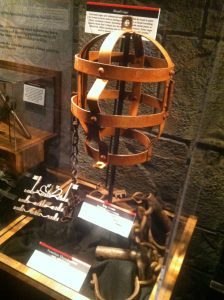 Hundreds of years ago, grisly torture techniques were the norm. Torture was ubiquitous and inevitable as both an investigative and punishment technique for serious crimes.
Hundreds of years ago, grisly torture techniques were the norm. Torture was ubiquitous and inevitable as both an investigative and punishment technique for serious crimes.
Throughout the years, law enforcement bodies used the facial harness, better known as the “head cage,” as a method of torture. Prisoners would be forced to wear the head cage, which locked the head in place, while their jailers tortured them. Restraining the victim’s arms and legs as well, which would crush any hope of escape or bodily defense. Eye gouging or branding with white hot prongs often would follow the prisoner’s restraint.
Some of these cages featured tongue-pieces called “the branks” or “scold’s bridle,” which originated in 16th century Scotland before journeying to America via England. These tongue-pieces included spikes or thorny wheels called rowels and would be shoved into the captives’ mouths. Besides the obvious wounds that these mechanisms inflicted, the cages also muffled screams and prevented effective communication.
The branks often included an attached chain for imprisoning the wearer in public. Residences in Cheshire even had a hook on the wall by the fireplace that the town jail-keeper could link the community branks to in the event a man’s wife was being uncooperative or bothersome — women could essentially be held captive in their own homes. Sometimes, the jail-keeper would hook a bell on a spring to the branks to indicate that the wearer was in the area and to serve as a form of embarrassment. People at the time also assumed that the branks would stop witches from casting magic spells since it prevented them from chanting.
The head cage was used mostly as a torture device during Medieval times. Once it reached North and South America, the branks became primarily a form of humiliation.
Back to Crime Library
|
|
|
